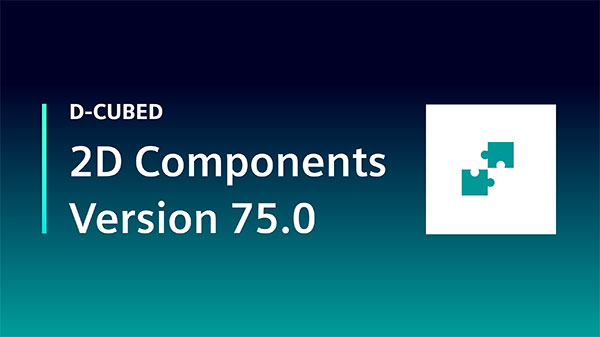Siemens Announces D-Cubed Releases
The D-Cubed applications are used to design, analyze, visualize and manufacture products from consumer goods to aircraft engines and commercial buildings.

D-Cubed 2D DCM (2D Dimensional Constraint Manager) is a 2D geometric constraint solver. 2D DCM is used in CAM, CAE and other geometry-based applications. Image courtesy of Siemens.
Latest News
February 9, 2023
Siemens has released D-Cubed 2D DCM version 75.0. D-Cubed 2D components are integrated by software developers to add functionality to the sketching environment of CAD/CAM/CAE and architecture, engineering and construction software applications. These applications are used to design, analyze, visualize and manufacture products from consumer goods to aircraft engines and commercial buildings.
D-Cubed 2D DCM (2D Dimensional Constraint Manager) is a 2D geometric constraint solver. In addition to driving the sketcher in many CAD products, 2D DCM is used in CAM, CAE and other geometry-based applications. A few of the enhancements introduced in version 75.0 of D-Cubed 2D DCM are described here.
Alignment Control for Symmetry Constraints
The 2D DCM enables engineers to apply rules of symmetry in their designs, so that any two defined collections of geometry will remain precisely reflected about a given axis of symmetry, while any other aspects of the wider sketch are being modified. This higher level ability to “mirror” arbitrary components in a sketch is an important capability in productive design applications.
Alignment Control for Normal Constraints
Version 75 also introduces alignment control for the normal constraint. A normal constraint can be applied between a curve and line that intersect, or between two curves that intersect. At the point of intersection, the tangent direction of the curve is constrained perpendicular to the direction of the line, or to the tangent direction of the other curve.
Performance Enhancements for Symmetry
2D DCM supports advanced constraint types such as symmetry as well as linear or circular patterns of repeated elements. This release further improves performance for constraints that are often used with large, simple symmetric sketches and pattern arrays.
In another recent product update, Siemens released D-Cubed 3D Components and shared its highlights.
D-Cubed 3D components are integrated by software developers to add 3D modeling capabilities to CAD/CAM/CAE and AEC software applications. These applications are used to design, analyse, visualize, and manufacture products from consumer goods to aircraft engines and commercial buildings.
D-Cubed 3D DCM Version 60.0
D-Cubed 3D DCM (3D Dimensional Constraint Manager) is a geometric constraint solving software component. Supporting a range of geometries, dimensions and constraints, 3D DCM enables 3D parametric sketching, part shape control using direct modeling, assembly part positioning and kinematic motion simulation. Key enhancements introduced in version 60.0 of D-Cubed 3D DCM are described below.
Constrain to Planar Component of a Circle or Torus
New functionality enables a dimension or coincident constraint to apply directly between a point and the planar component of a circle or torus.
Sets with Transforms
3D DCM supports grouping of geometry into a set, which can be used to define a rigid 3D part. This provides a method for positioning a 3D part using geometric constraints, while ensuring constraints will not affect the part’s shape. To mitigate against any potential loss of solving accuracy when positioning sets over large distances, the latest version enables applications to specify the transformation of the set in which geometry has been grouped.
Under-Defined Degrees of Freedom of a Set
When dimensions and constraints are used to position 3D parts in assemblies, they remove the parts’ degrees of freedom. In the absence of any positioning constraints, 3D parts have no unique location along X, Y and Z axes, and no unique rotation about those same axes. This usually results in 6 degrees of freedom for any given part.
For more details on D-Cubed 3D DCM Version 60.0 and D-Cubed CDM version 60.0, click here.
Sources: Press materials received from the company and additional information gleaned from the company’s website.
More Siemens Digital Industries Software Coverage
Subscribe to our FREE magazine, FREE email newsletters or both!
Latest News
About the Author
DE’s editors contribute news and new product announcements to Digital Engineering.
Press releases may be sent to them via [email protected].






